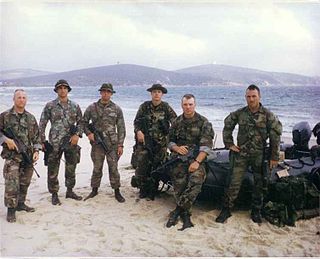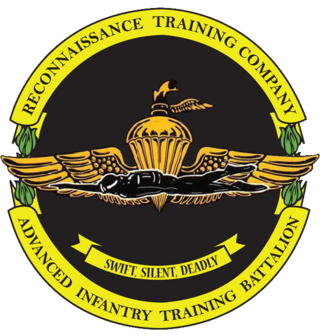
Force Reconnaissance (FORECON) are special operations capable forces companies unit of the United States Marine Corps and part of the Fleet Marine Force that provide gathering military intelligence to the command element of the Marine Air-Ground Task Force (MAGTF). Force Reconnaissance companies report to the Marine expeditionary force (MEF) and provide amphibious reconnaissance to support amphibious warfare operations, deep reconnaissance, direct action against important strategic or tactical goals, irregular warfare, ISTAR, long-range penetration, and special reconnaissance during large-scale operations.
The School of Infantry (SOI) is the second stage of initial military training for enlisted United States Marines after recruit training. The ITB now called IMC went from a 59 day course to 14 week course. Since the initial training pipeline is divided between coasts, Marines from areas east of the Mississippi River usually graduate from MCRD Parris Island and move on to SOI at SOI East, while those from the western half of the nation attend MCRD San Diego and move on to SOI West at the Camp San Onofre area of Camp Pendleton in California. Female Marines are trained at both SOI East and SOI West. The School of Infantry's training mission ensures "Every Marine is, first and foremost, a Rifleman". At SOI, Marines with the Military Occupational Specialty of infantry are trained at the Infantry Training Battalion (ITB), while all non-infantry Marines are trained in basic infantry and combat skills at the Marine Combat Training Battalion. SOI marks a transition in the professional training of entry-level students from basically trained Marines to combat-ready Marines.

The Basic School (TBS) is where all newly commissioned and appointed United States Marine Corps officers are taught the basics of being an "Officer of Marines." The Basic School is located in Stafford County, Virginia to the south-west of the Marine Corps Base Quantico complex. Each year, over 1,700 new officers are trained, representing such commissioning sources as the U.S. Naval Academy, Navy ROTC, Officer Candidates School, and newly appointed Marine Corps Warrant Officers, U.S. Merchant Marine Academy accession programs.

Insignia and badges of the United States Marine Corps are military "badges" issued by the United States Department of the Navy to Marines who achieve certain qualifications and accomplishments while serving on active or reserve duty in the United States Marine Corps.

The United States Marine Corps Reconnaissance Battalions are the special operations capable forces assets of Marine air–ground task force (MAGTF) that provide division-level amphibious reconnaissance, counter reconnaissance, direct action, ground reconnaissance, irregular warfare, long-range penetration, maneuver warfare, and special reconnaissance to the Ground Combat Element within the United States Marine Corps (USMC). Division reconnaissance teams are employed to observe and report on enemy activity and other information of military significance in close operations. The Military Occupational Specialty code for Reconnaissance Marine is 0321.

United States Marine Corps Scout Sniper was a secondary MOS designator of U.S. Marine Corps infantrymen and reconnaissance Marines that have graduated from a U.S. Marine Corps Scout Sniper School. Scout Snipers must earn the rank of Lance Corporal, be selected by their battalion to join the scout-sniper platoon, and complete an approved scout-sniper course in order to receive this designation. As of December 2023, Marine scout snipers have been reorganized as MOS 0322 Reconnaissance Sniper Marines, as part of a 26-Marine Scout Platoon.

The Radio Reconnaissance Platoon is a specially trained Marine Corps Intelligence element of a United States Marine Corps Radio Battalion. A Radio Reconnaissance Team (RRT) was assigned as the tactical signals intelligence collection element for the Marine Corps Special Operations Command, Detachment One. Regular RRTs also participate in SOC operations during Marine Expeditionary Unit, or MEU(SOC), deployments.
In the United States Marine Corps, a Marine air–ground task force is the principal organization for all missions across the range of military operations. MAGTFs are a balanced air–ground, combined arms task organization of Marine Corps forces under a single commander that is structured to accomplish a specific mission. The MAGTF was formalized by the publishing of Marine Corps Order 3120.3 in December 1963, "The Marine Corps in the National Defense, MCDP 1-0". It stated:
A Marine air–ground task force with separate air ground headquarters is normally formed for combat operations and training exercises in which substantial combat forces of both Marine aviation and Marine ground units are included in the task organization of participating Marine forces.

The 4th Reconnaissance Battalion is a reserve reconnaissance battalion in the United States Marine Corps. It falls under the 4th Marine Division and Marine Forces Reserve.

The United States Marine Corps is organized within the Department of the Navy, which is led by the Secretary of the Navy (SECNAV). The most senior Marine commissioned officer is the Commandant of the Marine Corps, responsible for organizing, recruiting, training, and equipping the Marine Corps so that it is ready for operation under the command of the unified combatant commanders. The Marine Corps is organized into four principal subdivisions: Headquarters Marine Corps, the Operating Forces, the Supporting Establishment, and the Marine Forces Reserve.

MOS 0311 is the United States Marine Corps (USMC) Military Occupational Specialty (MOS) code for infantry rifleman. It is the primary infantry MOS for enlisted Marines.
In the United States Marine Corps, the ground combat element (GCE) is the land force of a Marine Air-Ground Task Force (MAGTF). It provides power projection and force for the MAGTF.
The Marine Corps Test Unit 1, or MCTU #1, was an experimental testing unit of the United States Marine Corps. It was established outside the Fleet Marine Force for the development of specialized tactics, techniques and organizational concepts, and to evaluate its tangible employment in the nuclear age. It reported directly to the Commandant of the Marine Corps.

A Special Amphibious Reconnaissance Corpsman (SARC) is a United States Navy hospital corpsman who provides MARSOC and other USSOCOM units advanced trauma management associated with combatant diving and parachute entry. Traditionally, they are attached to the Marine Corps Force Reconnaissance companies to help support the Command Element of the Marine Air-Ground Task Force in special reconnaissance missions.
The reconnaissance mission within the United States Marine Corps is divided into two distinct but complementary aspects; Marine Division Recon and Force Reconnaissance.

The USMC Combatant Diver Course is taught at the Navy Diving and Salvage Training Center, Naval Support Activity Panama City, Panama City, Florida. Both of the Marine Air-Ground Task Force reconnaissance assets, FMF Recon and MarDiv Recon, widely use combatant diving. During this eight-week course, trainees are introduced to open and closed-circuit diving, diving physics and medical aid. Most of the training in combatant diving is done at night.
The United States Marine Corps Scout and Sniper companies and the Scouts (Tank) companies of the tank battalions were the first among the division's reconnaissance assets. They existed around the same exact moment when 1st and 2nd Marine Division were created. In 1941, each regiment had a scout and sniper platoon. They were assigned to the regimental Headquarters and Service Company. These companies were used in variety of tasks and, on occasion in severe combat, were used as "spare" rifle companies. When 6th Marine Division deactivated after the end of World War II, its recon assets also deactivated. Only the current Marine Division Recon Battalions that exist today hold history reference to the Scout and Sniper Companies.

The United States Marine Corps Reconnaissance Training Company trains Marines in the amphibious environment as a Reconnaissance Marine, MOS 0321. It is under the Advanced Infantry Training Battalion (AITB) of the School of Infantry (West), Marine Corps Base Camp Pendleton, California.

A critical skills operator (CSO) is a United States Marine in the primary special operations career field of the United States Marine Forces Special Operations Command (MARSOC). CSOs, colloquially known as "Raiders", are awarded the Military Occupational Specialty 0372. CSOs are assigned to Marine Special Operations Teams (MSOT), Companies (MSOC) and Battalions (MSOBs). CSOs are trained to execute a variety of missions. Specialized training also provides capabilities in language fluency necessary for crossing cultural barriers, allowing CSOs to connect with local forces and civilians. It takes, at a minimum, four and a half years to create a Marine CSO; a Marine must have served a minimum of three years or achieved the rank of at least lance corporal before being considered a MARSOC candidate.
Ground Intelligence Officer is a primary military occupation code of a U.S. Marine Corps intelligence officer. Ground intelligence officers serve as staff officers and commanders in the operating forces and are responsible for analyzing intelligence and planning, deployment and tactical employment of ground surveillance and reconnaissance units. The Ground Intelligence Officer can be a Recon Marine after their training is done.
















